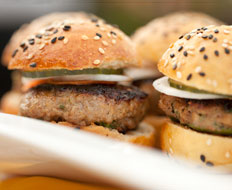Just one year into the National Pork Board’s “Be Inspired” campaign, chefs and operators have taken the challenge to heart and debuted innovative pork offerings throughout the foodservice industry.
The culinary ingenuity was showcased at this year’s Pork Summit, hosted by the National Pork Board at the Culinary Institute of America (CIA) in California’s Napa Valley. The second-annual, invitation-only event featured chefs showcasing all of the latest pork trends for operators and other culinary professionals.
Similar to 2011’s event, the purpose of the 2012 Pork Summit was to encourage foodservice professionals to explore pork innovation in their operations. On display were not only demonstrations of how to incorporate pork into the menu, but also success stories of chefs who did so after the 2011 Summit.
One of last year’s Pork Summit chefs, Chef Tom Pizzica of the Food Network’s “Outrageous Food” fame, had demonstrated a pork belly slider made with fried pepper aioli, tomatillos, and a spiced red onion and radish dressing. Now that demo is a business. Pizzica took the idea of a 100 percent pork-belly slider home to San Francisco and put it to the test in a pop-up restaurant.
“People kept coming up to me saying, ‘Dude, what is that?’” Pizzica says of his pop-up restaurant, Belly Burger. He asked himself: “How come nobody ever thought of this?”
Today, Belly Burger continues as a pop-up, but it also operates out of what Pizzica has dubbed The Pork Wagon. The van satisfies Belly Burger’s fan base, he says, which continues to grow for good reason: Pizzica offers pork belly flavorful, simple, fast, and cheap ($5 a pop). “I think the [pork] belly is the best use in a quick-serve environment,” he says. “I want belly because it’s delicious and it makes the best burger.”
Belly Burgers have no more than five ingredients, Pizzica says, including sauce, a vegetable, and “a crunch” like cucumber, jalapeño, or crispy cheese, on top of the pork belly. “If you can’t get it done in five,” he says, “you’re not getting it done.” With varieties such as the Philly Porker, with sautéed broccoli rabe, sharp provolone, and rosemary mayo; and the Alabama Ma’ama, with white barbecue sauce, fried yams, and sliced white onion, Pizzica seems to be getting it done.
The National Pork Board is hoping this year’s demonstrations will similarly inspire operators and help put pork on more menus across the country. The 2012 Pork Summit showed off innovations that included homemade Italian sausage from the CIA’s Chef Lars Kronmark; Virginia ham with pimento cheese and bread-and-butter pickles from Chef Jason Alley, executive chef at Richmond, Virginia’s Comfort and Pasture; guanciale (cured pig jowls) and bucatini from Chef Chad Colby of Los Angeles–based Mozza2Go; pork-face scrapple by Chef Adam Sappington of the Country Cat in Portland, Oregon; and a taste of Southeast Asian cuisine with lab moo lanna from Chef Robert Danhi, author of Easy Thai Cooking.
Other quick-serve-friendly dishes featured at the Summit included two grilled pizzas, one with pork sausage, roasted peppers, smoked mozzarella, and fontina cheeses, the other topped with fig port jam, prosciutto, and goat cheese; a grab-and-go pork-belly yakitori with kaffir-lime chili chicharrones; a pork meatball banh mi with pickled vegetables, spicy mayo, and cilantro; and pork-and-raisin empanadas with guajillo chili salsa.
Stephen Gerike, director of food service marketing for the National Pork Board, taught in a “Pork 101” class that a dish is only as good as the sum of its parts, and that starting with a quality pork product is essential to impart optimal flavor and texture. “There is no quality rating for pork—beef has prime, choice, etc.—so breeds and how they’re raised is its point of distinction,” Gerike said during the course.
Improper processing, Gerike continued, results in pale, dry pork referenced as PSE (pale, soft, and exudative), which has lost too much moisture, or the dark and dry DFD (dark, firm, and dry), which holds too much moisture. Ideally, he said, pork should be a reddish color and moist RFN (red, firm, and non-exudative).
The overriding theme at the Pork Summit? Operators who place an emphasis on pork quality and flavor can put even the most basic dish over the top. Just ask Sappington, who found mass success with a breakfast staple at his restaurant that is cured and butchered in-house.
“Scrambled eggs and bacon—it’s the bread and butter of the restaurant,” Sappington says. “People stand in line for two-and-a-half hours [to get some].”









